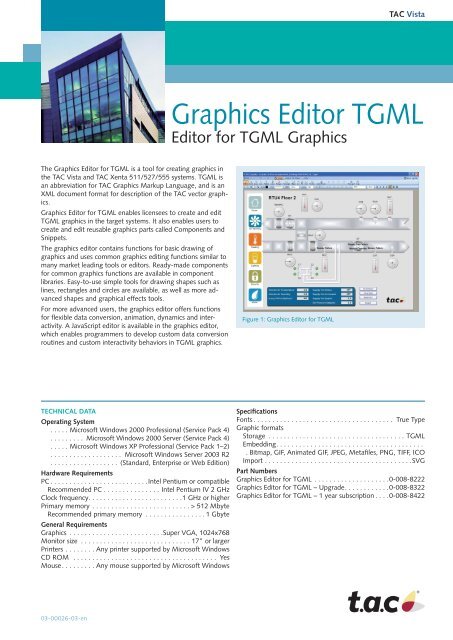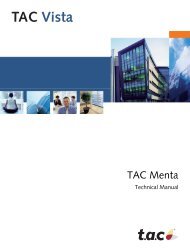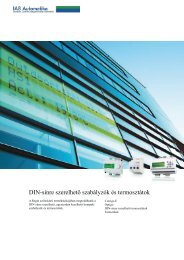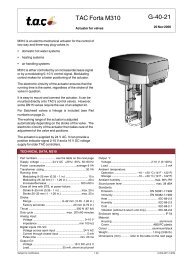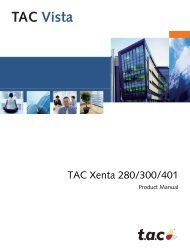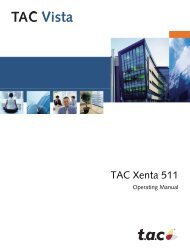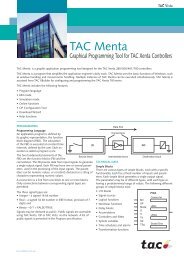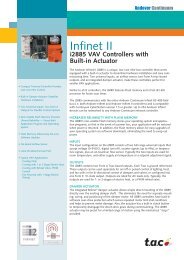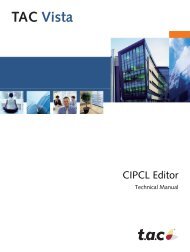Graphics Editor TGML - IAS Automatika
Graphics Editor TGML - IAS Automatika
Graphics Editor TGML - IAS Automatika
Create successful ePaper yourself
Turn your PDF publications into a flip-book with our unique Google optimized e-Paper software.
<strong>Graphics</strong> <strong>Editor</strong> <strong>TGML</strong><br />
<strong>Editor</strong> for <strong>TGML</strong> <strong>Graphics</strong><br />
The <strong>Graphics</strong> <strong>Editor</strong> for <strong>TGML</strong> is a tool for creating graphics in<br />
the TAC Vista and TAC Xenta 511/527/555 systems. <strong>TGML</strong> is<br />
an abbreviation for TAC <strong>Graphics</strong> Markup Language, and is an<br />
XML document format for description of the TAC vector graphics.<br />
<strong>Graphics</strong> <strong>Editor</strong> for <strong>TGML</strong> enables licensees to create and edit<br />
<strong>TGML</strong> graphics in the target systems. It also enables users to<br />
create and edit reusable graphics parts called Components and<br />
Snippets.<br />
The graphics editor contains functions for basic drawing of<br />
graphics and uses common graphics editing functions similar to<br />
many market leading tools or editors. Ready-made components<br />
for common graphics functions are available in component<br />
libraries. Easy-to-use simple tools for drawing shapes such as<br />
lines, rectangles and circles are available, as well as more advanced<br />
shapes and graphical effects tools.<br />
For more advanced users, the graphics editor offers functions<br />
for flexible data conversion, animation, dynamics and interactivity.<br />
A JavaScript editor is available in the graphics editor,<br />
which enables programmers to develop custom data conversion<br />
routines and custom interactivity behaviors in <strong>TGML</strong> graphics.<br />
Figure 1: <strong>Graphics</strong> <strong>Editor</strong> for <strong>TGML</strong><br />
Technical Data<br />
Operating System<br />
. . . . . Microsoft Windows 2000 Professional (Service Pack 4)<br />
. . . . . . . . . Microsoft Windows 2000 Server (Service Pack 4)<br />
. . . . . Microsoft Windows XP Professional (Service Pack 1–2)<br />
. . . . . . . . . . . . . . . . . . . Microsoft Windows Server 2003 R2<br />
. . . . . . . . . . . . . . . . . . (Standard, Enterprise or Web Edition)<br />
Hardware Requirements<br />
PC . . . . . . . . . . . . . . . . . . . . . . . . . .Intel Pentium or compatible<br />
Recommended PC . . . . . . . . . . . . . . . Intel Pentium IV 2 GHz<br />
Clock frequency. . . . . . . . . . . . . . . . . . . . . . . . .1 GHz or higher<br />
Primary memory . . . . . . . . . . . . . . . . . . . . . . . . . . > 512 Mbyte<br />
Recommended primary memory . . . . . . . . . . . . . . . . 1 Gbyte<br />
General Requirements<br />
<strong>Graphics</strong> . . . . . . . . . . . . . . . . . . . . . . . . .Super VGA, 1024x768<br />
Monitor size . . . . . . . . . . . . . . . . . . . . . . . . . . . . . 17” or larger<br />
Printers . . . . . . . . Any printer supported by Microsoft Windows<br />
CD ROM . . . . . . . . . . . . . . . . . . . . . . . . . . . . . . . . . . . . . . Yes<br />
Mouse. . . . . . . . . Any mouse supported by Microsoft Windows<br />
Specifications<br />
Fonts . . . . . . . . . . . . . . . . . . . . . . . . . . . . . . . . . . . . . True Type<br />
Graphic formats<br />
Storage . . . . . . . . . . . . . . . . . . . . . . . . . . . . . . . . . . . . <strong>TGML</strong><br />
Embedding. . . . . . . . . . . . . . . . . . . . . . . . . . . . . . . . . . . . . . .<br />
. Bitmap, GIF, Animated GIF, JPEG, Metafiles, PNG, TIFF, ICO<br />
Import . . . . . . . . . . . . . . . . . . . . . . . . . . . . . . . . . . . . . . .SVG<br />
Part Numbers<br />
<strong>Graphics</strong> <strong>Editor</strong> for <strong>TGML</strong> . . . . . . . . . . . . . . . . . . . .0-008-8222<br />
<strong>Graphics</strong> <strong>Editor</strong> for <strong>TGML</strong> – Upgrade. . . . . . . . . . . .0-008-8322<br />
<strong>Graphics</strong> <strong>Editor</strong> for <strong>TGML</strong> – 1 year subscription . . . .0-008-8422<br />
03-00026-03-en
Functions<br />
Engineering<br />
• Components and Symbols – Readymade<br />
objects are available in the Components<br />
and Snippets panes.<br />
– Basic Controls<br />
– DIN Symbols (EN)<br />
– ISO Symbols<br />
– TAC Vista Symbols (EN)<br />
– Basic Functions Snippets<br />
A growing set of components and<br />
other graphics is published by TAC and<br />
others on http://graphics.tac.com<br />
• Drag’n drop – Drag’n drop of components<br />
to the drawing surface. Components<br />
can also be dropped on e-mail<br />
message, MSN Messenger or Windows<br />
Explorer windows for easy distribution.<br />
• Bindings – Connections to control<br />
system data are done through bindings.<br />
A Bindings window is available<br />
in the editor for convenience for users<br />
to create connections. Connections to<br />
bindings are primarily performed within<br />
the target system.<br />
• Links – A Links window enables users<br />
to link graphics objects to other objects<br />
such as other graphics, trend charts or<br />
reports.<br />
• Properties – A property grid enables<br />
easy editing of single or multiple selected<br />
graphics objects.<br />
• Objects – The Objects window presents<br />
the objects of a <strong>TGML</strong> document in a<br />
hierarchical form and allows users to<br />
re-arrange, move, duplicate and edit<br />
objects.<br />
• Printing – The editor provides functions<br />
for printing and print preview.<br />
• Help – Extensive online help available.<br />
Basic Drawing<br />
• Shapes – A number of basic drawing<br />
tools are available within the graphics<br />
editor that allow users to create graphics<br />
such as flow diagrams, floor plans,<br />
maps, navigational maps or any type of<br />
presentation of dynamic data.<br />
– Line<br />
– Polyline<br />
– Curve<br />
– Polygon<br />
– Rectangle<br />
– Ellipse<br />
– Arc<br />
– Pie<br />
– Text<br />
– Textbox<br />
– Picture<br />
• Options – A multitude of drawing<br />
options are available to enable users<br />
to create good looking and intuitive<br />
graphics.<br />
– Fill<br />
– Stroke<br />
– Style<br />
– Width<br />
– Corner<br />
– Font<br />
– Font size<br />
– Font style<br />
– Justification<br />
• Effects – The graphics effects capabilities<br />
are improved and the graphics<br />
editor contains functions for editing<br />
effects such as gradients and semitransparent<br />
colors.<br />
• Editing – Many functions are available<br />
in the editor for common editing<br />
tasks such as moving, resizing, aligning,<br />
rotating, changing drawing order,<br />
copying and pasting.<br />
Other Formats<br />
• Image embedding – Images such as<br />
photos or illustrations can be embedded<br />
into <strong>TGML</strong> graphics. Most common<br />
formats are supported.<br />
• Import – The system has the capability<br />
to convert other drawing formats to<br />
<strong>TGML</strong>. After conversion, the imported<br />
drawings can be edited and managed<br />
as any <strong>TGML</strong> graphical object.<br />
Advanced Functions<br />
• Animations – A built-in advanced animation<br />
engine allows users to animate<br />
most attributes of objects used in a<br />
<strong>TGML</strong> document. Animations can be<br />
used to improve operators’ user experience.<br />
• Dynamics – Any <strong>TGML</strong> object’s attribute<br />
can be configured to be controlled<br />
by data from the control system.<br />
• Conversions – Powerful ready-made<br />
functions are available to convert data<br />
from the control system format to what<br />
is required for the <strong>TGML</strong> graphics. For<br />
instance, analog values can be converted<br />
to colors, binary values can control<br />
animations, values can be scaled etc.<br />
• Custom conversions – Going beyond<br />
the ready conversion functions is not a<br />
problem with the script based custom<br />
conversion functionality.<br />
• Interactivity – It is easy to create re-usable<br />
components that use the default<br />
Workstation or web behavior when users<br />
click on the object. For even richer<br />
and more tailored user experience, the<br />
default behaviors can be overridden<br />
using scripts.<br />
• Error indication – <strong>TGML</strong> graphics uses<br />
the default error indication methods<br />
for the target system platform. Custom<br />
error indication can be developed using<br />
scripts.<br />
• Scripting – The scripting language for<br />
custom conversions, custom animations,<br />
custom interactions and for custom<br />
error indications is JavaScript, the<br />
same scripting language that is used in<br />
most web browsers and in many other<br />
off-the-shelf software systems.<br />
• Document information – A <strong>TGML</strong><br />
graphic contains data fields that can be<br />
used for specifying information about<br />
the document. The graphics editor provides<br />
the function for editing that data.<br />
Copyright © 2007, TAC<br />
All brand names, trademarks and registered trademarks are<br />
the property of their respective owners. Information contained<br />
within this document is subject to change<br />
without notice. All rights reserved.<br />
03-00026-03-en<br />
Europe / Headquarters<br />
Malmö, Sweden<br />
+46 40 38 68 50<br />
Americas<br />
Dallas, TX<br />
+1 972-323-1111<br />
Asia-Pacific<br />
Sydney, Australia<br />
+61 2 9700 1555<br />
www.tac.com


